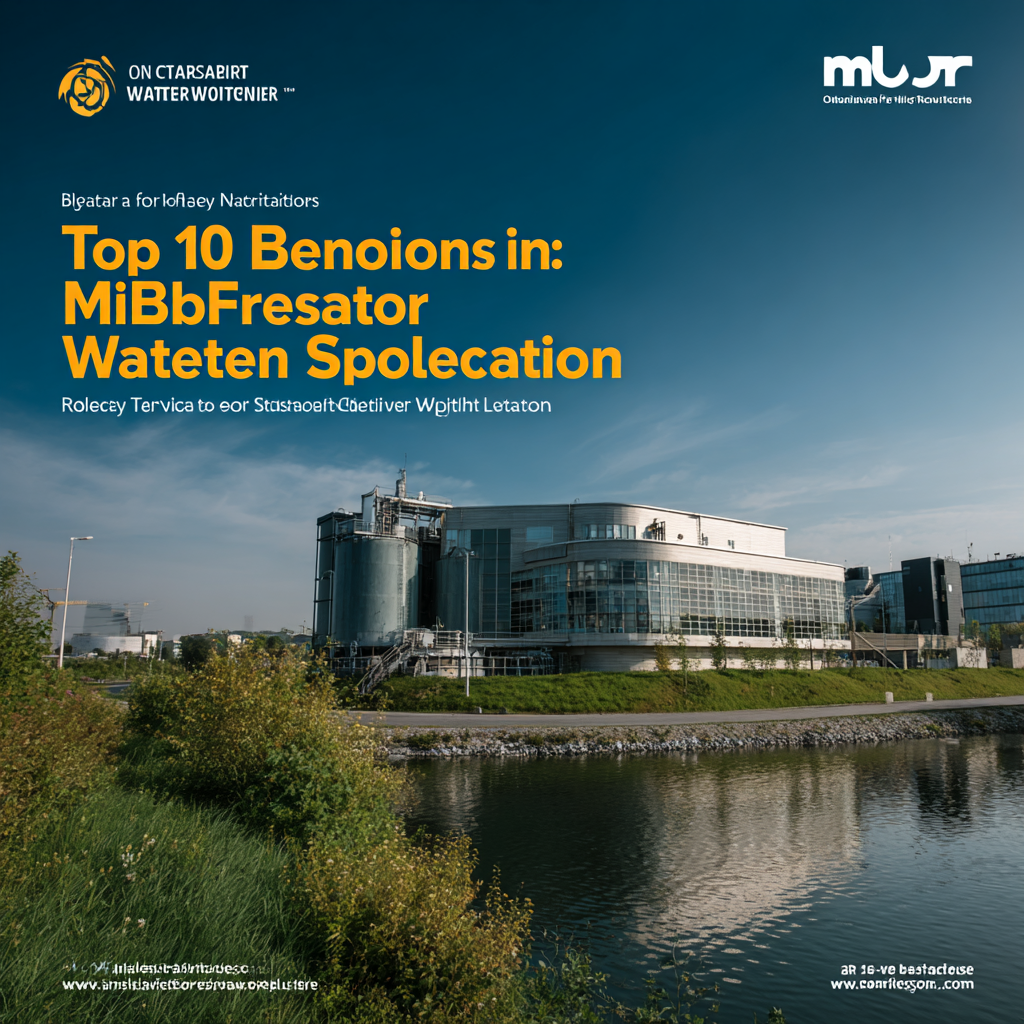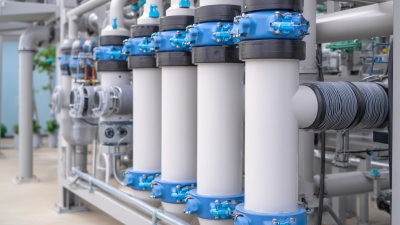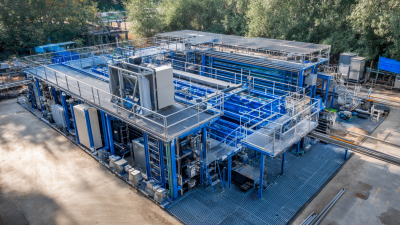 +86 13600513715
+86 13600513715



In the realm of wastewater treatment, the MBBR (Moving Bed Biofilm Reactor) bioreactor stands out as a revolutionary technology, enhancing efficiency and sustainability in processing wastewater. As Dr. Jane Smith, a leading expert in environmental engineering, aptly stated, "The MBBR bioreactor not only addresses the growing challenges of wastewater management but also plays a critical role in promoting ecological balance." This innovative approach utilizes biofilm technology to maximize the contact between bacteria and wastewater, leading to improved degradation of pollutants.
The numerous benefits of employing MBBR bioreactors make them a favorable choice for treatment solutions across various industries. From their ability to handle fluctuating loads to significant reductions in sludge production, these bioreactors offer a remarkable solution to some of the most pressing environmental challenges. As we delve deeper into the top 10 benefits of using MBBR bioreactors for wastewater treatment, it becomes clear how this technology is not only transforming operational efficiencies but also supporting sustainable practices in wastewater management.

Moving towards efficient wastewater management, MBBR (Moving Bed Biofilm Reactor) technology has emerged as a leading solution in the industry. With an estimated 30% increase in treatment efficiency compared to conventional methods, MBBR leverages both biofilm and suspended growth, maximizing organic matter degradation. A report by the Global Water Intelligence indicates that facilities utilizing MBBR technology can achieve up to 90% removal rates of BOD (Biochemical Oxygen Demand), making it an attractive option for municipal and industrial applications alike.
The adaptability of MBBR systems is particularly noteworthy. They can be customized to meet varying operational conditions, which is crucial in a world of evolving environmental standards and regulations. According to a study published by the International Journal of Environmental Research, plants employing MBBR technology have demonstrated a 50% reduction in footprint compared to traditional treatment systems. This compact design not only reduces capital investment but also lowers operational costs, allowing wastewater treatment facilities to optimize their resources while enhancing sustainability practices. As industries strive for greener solutions, the advantages of MBBR technology in modern wastewater management cannot be overstated.
The chart below illustrates the top 10 benefits of MBBR technology in modern wastewater management.
The MBBR (Moving Bed Biofilm Reactor) bioreactor design stands out for its exceptional space utilization, making it an appealing choice for wastewater treatment solutions. Unlike traditional systems that require extensive land area, MBBR technology integrates biofilm carriers suspended in the reactor. This design maximizes the surface area available for microbial growth while maintaining a compact footprint. By employing a continuous-flow system, MBBR can treat higher volumes of wastewater in significantly less space, which is especially beneficial in urban settings where land is at a premium.
In addition to efficient space utilization, MBBR systems promote improved operational flexibility. The modular nature of these systems allows for easy scaling; facilities can be expanded or contracted based on treatment needs without a complete redesign. Moreover, the bioreactor's robust design provides resilience to fluctuations in influent characteristics, ensuring consistent performance. This combination of compact design and operational adaptability makes MBBR bioreactors a forward-thinking solution for modern wastewater treatment challenges, providing both efficiency and reliability in diverse environments.
The cost-effectiveness of Moving Bed Biofilm Reactor (MBBR) technology in long-term wastewater treatment solutions is gaining recognition in the industry. MBBR systems require less space than traditional activated sludge processes, leading to reduced infrastructure costs. According to the Water Environment Federation, implementing an MBBR system can lower capital expenses by up to 25%. Additionally, operational costs are minimized due to the system's ability to handle fluctuating loads efficiently, which results in lower energy consumption and reduced chemical usage.
**Tips:** Consider integrating MBBR technology with other treatment processes, such as membrane bioreactors, to enhance overall efficiency and minimize costs even further. Regular maintenance and monitoring can also contribute to sustained performance and longevity, reducing the likelihood of unexpected expenses.
Furthermore, MBBR systems are known for their robustness and adaptability to various wastewater compositions, making them a viable option for municipal and industrial applications. A report from the Global Water Intelligence notes that MBBR technology can help facilities achieve up to a 30% reduction in operating costs over conventional methods. By optimizing biological treatment processes, facilities can ensure compliance with stringent discharge regulations while enjoying significant savings.
**Tips:** When evaluating wastewater treatment options, conduct a comprehensive cost-benefit analysis that takes into account potential savings over the lifespan of the MBBR system. Engage with experienced providers to tailor the system to your specific needs for maximizing efficiency and cost savings.
| Benefit | Description | Long-term Cost Savings |
|---|---|---|
| High Treatment Efficiency | MBBR bioreactors provide efficient removal of organic and inorganic pollutants. | Lower costs due to decreased need for additional treatment stages. |
| Compact Design | MBBR systems require less space compared to other treatment options. | Saves costs on land acquisition and construction. |
| Flexibility | Easily adaptable to a variety of wastewater types and volumes. | Reduces the need for multiple systems for different waste streams. |
| Low Energy Consumption | Requires less energy compared to conventional systems. | Significant savings on operational costs. |
| Robust Operation | Can function effectively under varying operational conditions. | Less downtime and lower maintenance costs. |
| Improved Sludge Settling | Produces high-quality effluent with less sludge production. | Lower disposal costs and reduced handling requirements. |
| Scalability | Easily scale up to meet increasing treatment demands. | Cost-effective expansion without major infrastructure changes. |
| Low Chemicals Usage | Minimizes the need for chemical additives in the treatment process. | Decreases operational costs related to chemical procurement. |
| Easier to Operate | User-friendly control systems reduce the need for specialized staff. | Lower personnel costs for operation and maintenance. |
| Enhanced Nitrogen Removal | High efficiency in nitrogen removal enhances effluent quality. | Reduces costs associated with regulatory compliance. |
 The Moving Bed Biofilm Reactor (MBBR) system offers significant advantages over traditional wastewater treatment methods, primarily due to its innovative design and operational efficiencies. One of the key enhancements is the use of biofilm carriers that provide a larger surface area for microbial growth. This results in improved biological treatment performance, as the microorganisms can thrive more effectively within this controlled environment. Unlike conventional systems that rely heavily on suspended solids, MBBR maintains optimal conditions for biofilm development, leading to a more stabilized and resilient treatment process.
The Moving Bed Biofilm Reactor (MBBR) system offers significant advantages over traditional wastewater treatment methods, primarily due to its innovative design and operational efficiencies. One of the key enhancements is the use of biofilm carriers that provide a larger surface area for microbial growth. This results in improved biological treatment performance, as the microorganisms can thrive more effectively within this controlled environment. Unlike conventional systems that rely heavily on suspended solids, MBBR maintains optimal conditions for biofilm development, leading to a more stabilized and resilient treatment process.
Additionally, MBBR systems exhibit greater flexibility and scalability compared to traditional methods. They can easily be integrated into existing wastewater treatment plants without the need for extensive modifications. This adaptability allows for increased treatment capacity and efficiency without compromising the quality of the effluent. Enhanced treatment performance in MBBR systems translates to more effective removal of organic matter and nutrients, ultimately leading to a cleaner discharge into water bodies, making this technology a preferred choice for modern wastewater management strategies.
The adoption of Moving Bed Biofilm Reactor (MBBR) technology in wastewater treatment not only enhances efficiency but also significantly contributes to environmental sustainability. One of the primary environmental benefits is the reduction of greenhouse gas emissions. Traditional treatment methods often release methane and nitrous oxide, potent contributors to climate change. MBBR systems, with their optimized biological processes, minimize these emissions by improving the overall efficiency of organic matter degradation.

Additionally, MBBR systems require less land area compared to conventional treatment options. This compact design leads to a smaller ecological footprint, allowing for the preservation of natural habitats. The modular nature of MBBRs also enables easier integration into existing treatment facilities, leading to reduced disruption of local ecosystems during upgrades. Furthermore, MBBR technology promotes the recycling of nutrients, as it facilitates the recovery of nitrogen and phosphorus, which can be repurposed as fertilizers, thus supporting sustainable agricultural practices.
These benefits illustrate the crucial role of MBBR technology in advancing environmental conservation efforts while efficiently managing wastewater.






